
by Jennifer Bearden | Feb 27, 2018

Fluffy Mimosa Bloom. Photo Credit: Mary Salinas
All along the roadsides and in home landscapes in summer, a profusion of fluffy pink blossoms are adorning trees known as mimosa, or Albizia julibrissin. This native of China was introduced to home landscapes in this country in the 1700’s to enjoy the fragrant, showy flowers and fine, lacy foliage. However, there is a dark side to this lovely tree. After blooming, it produces an abundance of pods each containing 5 to 10 seeds. Seeds can be spread by wildlife and water; this is evidenced by the appearance of mimosa trees along the roadways, streams and in our natural areas. The seeds can also remain dormant for many years, allowing the trees to keep sprouting long after the mother tree is gone.
Mimosa has been categorized as an invasive exotic plant in Florida by the University of Florida IFAS Assessment of Non-Native Plants in Florida’s Natural Areas. This designation means that the tree has not only naturalized, but is expanding on its own in Florida native plant communities. This expansion means that our native plants in natural areas get crowded out by mimosa as it reproduces so prolifically.
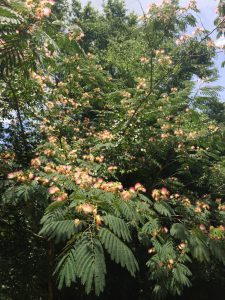
Mimosa tree in bloom. Photo Credit: Mary Salinas
The Florida Exotic Pest Plant Council (FLEPPC) publishes a list of non-native plants that have been determined to be invasive. Click here for the most recent 2017 list!
The first step in controlling this pest plant is to remove existing plants in the landscape. Cutting it down at soil level and immediately painting the stump with a 25% solution of glyphosate or triclopyr should do the trick. Further details and control methods can be found here.
There are some native trees that make excellent alternatives to mimosa such as fringe tree (Chionanthus virginicus), silverbell (Halesia carolina) and flowering dogwood (Cornus florida).
Guest Author:
Mary Salinas
Residential Horticulture Agent
Santa Rosa County
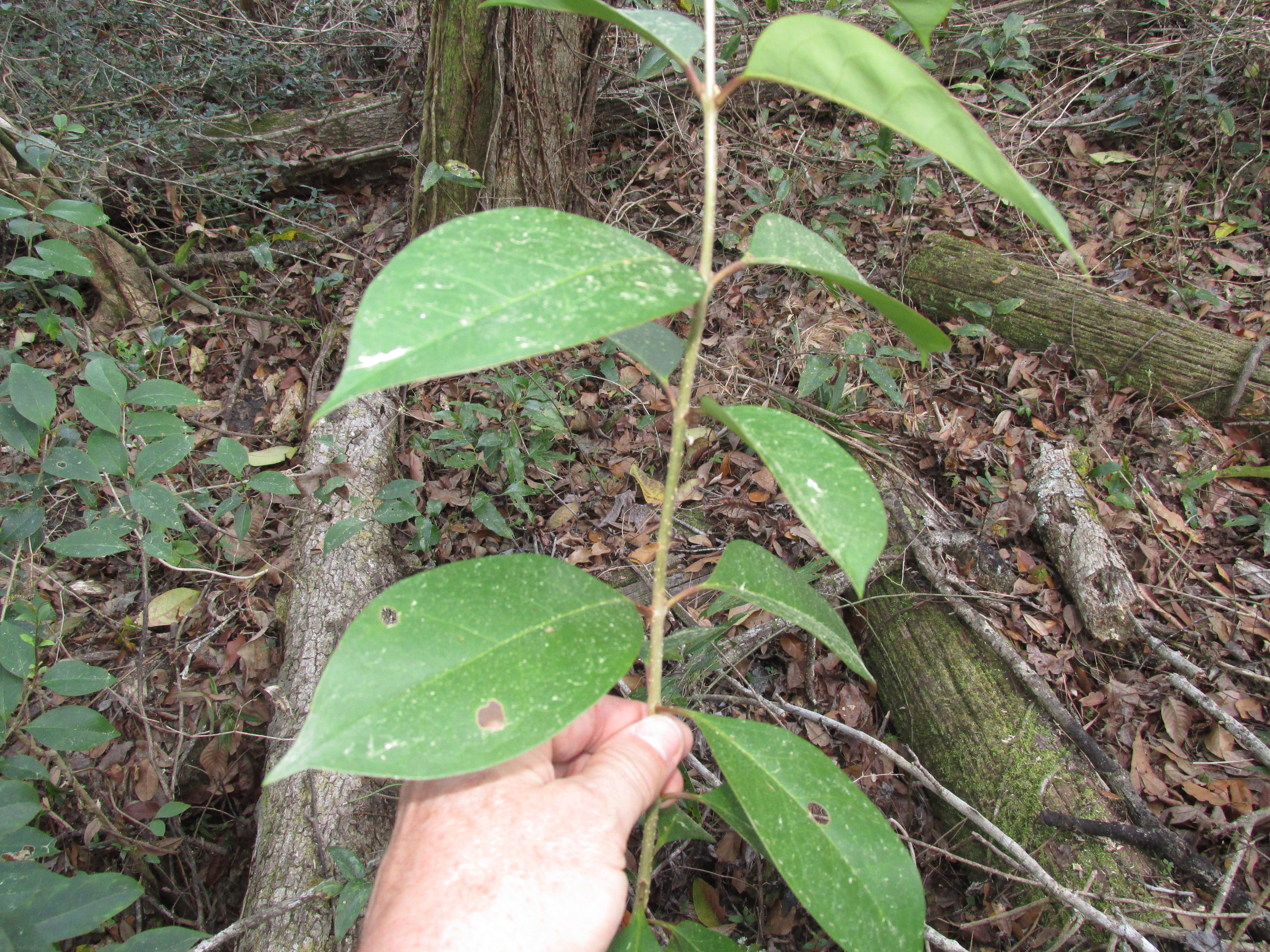
by Erik Lovestrand | Feb 26, 2018
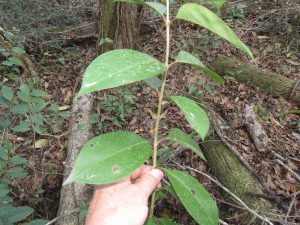
Tree privet in Wakulla County. The large shrub is rapidly becoming a dominant species in the understory of this woodlot. Photo Credit: Erik Lovestrand
Keep your eyes open for this Category 1 FLEPPC invader. When the Florida Exotic Pest Plant Council deems a plant a Category 1, it means that the plant is capable of altering native ecosystems by displacing native species. Other common names for this Ligustrum include glossy privet and wax-leaf ligustrum, which are fitting descriptions of the large, shiny leaves arranged oppositely on the stems. Belonging to the olive family (Oleaceae), this small tree can grow to 10 m tall and form a dense shady canopy above the forest understory. It has been documented in several Central to North Florida counties and has also escaped in Pennsylvania, Virginia, North Carolina, Texas, Georgia Alabama, Mississippi, Louisiana, Maryland, California and Hawaii, as well as other countries (K.A. Langeland, et al. University of Florida-IFAS Pub SP 257, 2008).
The typical growth pattern often involves multiple trunks with very smooth bark and twigs being dotted with numerous corky lenticels. Once a parent plant is established it will produce copious clusters of dark drupes that will blanket the understory with small seedlings in a short time due to very high germination rates. Birds are a likely dispersal mechanism also. It prefers a mesic hardwood hammock setting in North Florida and when cut down, readily re-sprouts with many new stems from the trunk. An herbicide application to stumps is a must for control. These plants can gain an advantage in many ways in our native habitats. They tend to be salt tolerant and are able to withstand fire well. They can grow in acidic to alkaline soils but do not do well in wet soil conditions. They will commonly colonize river banks though where the higher levees provide a deeper, sandier footing.
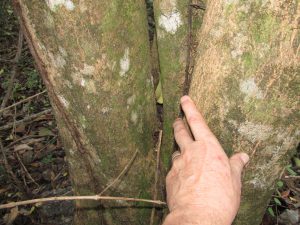
Large tree privet trunk in Wakulla County. Photo Credit: Erik Lovestrand
There are two other non-native ligustrums established in North Florida also but they are easy to separate if you look closely at the foliage. The plant commonly called Chinese ligustrum (l. sinense) has much smaller leaves. The more similar looking Japenese ligustrum (l. japonicum, also called wax-leaf privet), can be distinguished by the lack of a thin translucent margin along the leaf edges. This is easy to see if you hold a tree privet leaf against a backlit setting.
For more information on Ligustrum lucidum, visit the UF IFAS Center for Aquatic and Invasive Plants Directory
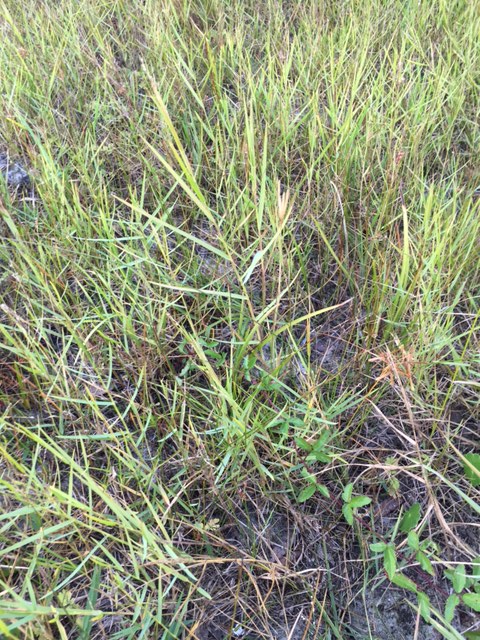
by Rick O'Connor | Feb 26, 2018

Invasive Torpedo Grass. Photo Credit: Rick O’Connor
The topic of invasive species has been with Floridians for decades. Stories of large pythons, exotic lizards, and crazy ants have been coming out of south Florida for years. Brazilian Pepper, Australian Pine, and Melaleuca are just three species of trees that have invaded the Everglades and other south Florida ecosystems.
Though we are having more problems with plants than animals, north Florida is not without their list of invasive problems. Cogongrass, Chinese Tallow, and Japanese Climbing Fern are well established and resource managers are constantly battling these and other invasives. In recent years Lionfish, Cuban Anoles, and a few sightings of Cuban Treefrogs have made their way onto our radar. All of these invasive species are causing either an environmental problem, an economic one, or both and need to be controlled. However, land and resource managers need to know what is out there to be able to do this; and the public can help.
So what can you do?
One of the most frequently used databases is www.EDDMaps.org. Land and resource managers, both public and private, can view this website to see which species are in the area, where they are located, and how common the species is. However, it is only as good as the data provided. Anyone can report an invasive species on EDDMaps.
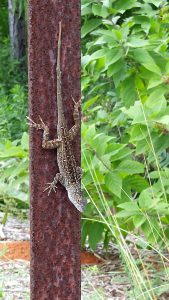
Invasive lizard – the Cuban Anole. Photo Credit; Jerry Patee.
From the home page, you can find a variety of information on invasive species. To report a sighting you will need an account. On the toolbar at the top, you will see REPORT SIGHTINGS. Clicking here will take you through a series of questions. There is some information that you need to have ready. For example, how much area of the property does the invasive plant cover? Estimates are fine but try to be as close as possible. You will also need to know your location. Most phones have a compass on them where the Latitude and Longitude are provided. However, it will need to be converted to decimal point to be posted and there is a conversion tool on the website to do this for you. It is important to report your Longitude as a negative number, or else it will think you are in the eastern hemisphere. Photos are very MUCH desired and, again, your phone photo is good enough. On the home page, you will also see how to download the app “I’ve Got One” which is a quick and easy way to report an invasive species while in the field.
If you are not familiar with many of the invasive species, you can spend some time on the website to learn more. You can also contact your local extension office to discuss species that we know are in the area and those that are nearby. These are good species to be on the watch for and, with your help, we can help keep the website updated.
The extension offices in the Pensacola area will be hosting trainings on invasive species identification and EDDMaps reporting later this year. If interested contact Rick O’Connor (850) 475-5230.
by Carrie Stevenson | Mar 3, 2017
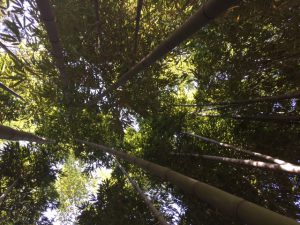
Bamboo shoots can grow as tall as 70 feet. Photo credit: Carrie Stevenson
Standing in the midst of a stand of bamboo, it’s easy to feel dwarfed. Smooth and sturdy, the hollow, sectioned woody shoots of this fascinating plant can tower as tall as 70 feet. Unfortunately, bamboo is a real threat to natural ecosystems, moving quickly through wooded areas, wetlands, and neighborhoods, taking out native species as it goes.
We do have one native species referred to as bamboo or cane (Arundinaria gigantea), which is found in reasonable numbers in southeastern wetlands and the banks of rivers. There are over a thousand species of true bamboo, but chief among the invasive varieties that give us trouble is Golden Bamboo (Phyllostachys aurea). Grown in its native Southeast Asia as a food source, building material, or for fishing rods, bamboo is also well known as the primary diet (99%) of the giant panda. In the United States, the plant was brought in as an ornamental—a fast growing vegetative screen that can also be used as flooring material or food. Clumping bamboos can be managed in a landscape, but the invasive, spreading bamboo will grow aggressively via roots and an extensive network of underground rhizomes that might extend more than 100 feet from their origin.
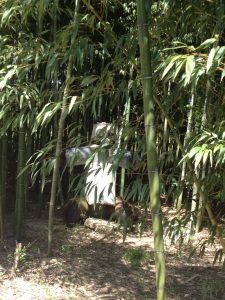
Whimsy art Panda in a bamboo forest at the Glendale Nature Preserve. Photo credit: Carrie Stevenson
As a perennial grass, bamboo grows straight up, quickly, and can withstand occasional cutting and mowing without impacts to its overall health. However, a repeated program of intensive mowing, as often as you’d mow a lawn and over several years, will be needed to keep the plant under control. Small patches can be dug up, and there has been some success with containing the rhizomes by installing an underground “wall” of wood, plastic, or metal 18” into the soil around a section of bamboo.
While there are currently no chemical methods of control specifically labeled for bamboo at this time, the herbicides imazapyr (trade name Arsenal and others) or glyphosate (Round-up, Rodeo) applied at high rates can control it. According to research on the topic, “bamboo should be mowed or chopped and allowed to regrow to a height of approximately 3 feet, or until the leaves expand. Glyphosate at a 5% solution or imazapyr as a 1% solution can then be applied directly to the leaves.” These treatments will often need to be repeated as many as four times before succeeding in complete control of bamboo.
Land managers should know that while imazapyr is typically a more effective herbicide for bamboo, it can kill surrounding beneficial trees and shrubs due to its persistence in the contiguous roots and soil. In contrast, glyphosate solutions will only kill the species to which it has been applied and is the best choice for most areas managed by homeowners.
Bamboo Control Publication
by Carrie Stevenson | Mar 2, 2017
Guest Blogger – Dr. Steve A. Johnson, Associate Professor & Extension Specialist, Department of Wildlife Ecology and Conservation, University of Florida
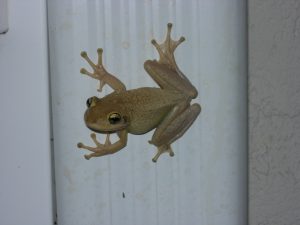
Cuban Treefrog. Photo credit: Steve Johnson
The National Invasive Species Council defines an invasive species as one that is introduced outside its native range where it causes harm (or is likely to) to the environment, economy, or human quality of life. The Cuban Treefrog in Florida qualifies as invasive under all three parts of this definition. Introduced from Cuba to Key West inadvertently in a shipment of cargo about 100 years ago, this frog is now established throughout Florida’s peninsula, and isolated records from numerous panhandle counties continue to accumulate. There are many records of Cuban Treefrogs from other states in the US, and even Canada. Most of these frogs originated in Florida and found their way to points beyond as hitchhikers on vehicles or as stowaways in shipments of ornamental plants. Fortunately, Cuban Treefrogs do not appear to have gained a permanent foothold—yet—outside of the Sunshine State.
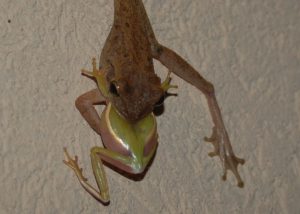
Cuban Treefrog eating a Green Treefrog. Photo Credit: Nancy Bennett
Cuban Treefrogs are well documented predators of Florida’s native treefrogs and are likely responsible for declines in native treefrog numbers, especially in suburban neighborhoods. Fortunately, research has shown that when native frogs (e.g., Squirrel and Green Treefrogs) are still present that they respond favorably to the removal of their invasive cousins. Cuban Treefrogs are known to seek shelter in electrical utility equipment or even a home air-conditioning units, and as they climb around they may cause short circuits, leading to costly repairs. They also invade homes, ending up in a toilet at times, and have also sent young children to the emergency room. The frogs exude a noxious skin secretion when handled, which is extremely irritating to mucous membranes, especially one’s eyes. So be sure to wash your hands thoroughly after handling a Cuban Treefrog.
To mitigate the negative impacts Cuban Treefrogs are having on Florida’s native wildlife, as well as their effects on our quality of life, I recommend that these invaders be captured and humanely euthanized. For tips on how to capture, identify, and humanely euthanize these frogs visit http://ufwildlife.ifas.ufl.edu/ and also read “The Cuban Treefrog in Florida”. Report sightings of this species outside of the Florida peninsula to Dr. Steve A. Johnson, and within the peninsula report them on EDDmapS.
by Rick O'Connor | Mar 2, 2017
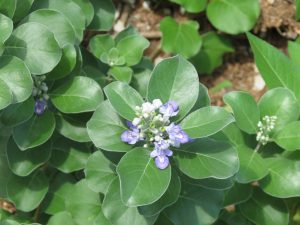
Beach Vitex Blossom. Photo credit: Rick O’Connor
Research shows that the most effective time to deal with an invasive species, both in terms of controlling or eradicating the species and money spent to do so, is early on…. What we call Early Detection Rapid Response. Beach vitex is a good candidate for this.
The first record for vitex in the Florida panhandle was in 2012. A local citizen in Gulf Breeze (Santa Rosa County) reported it on her beach and believed it may have come from Santa Rosa Island… it did. The barrier island location was logged on EDDmaps and the Gulf Breeze plants were removed. A quick survey of Florida on EDDmaps found that the only other location was in Duval County – 3 records there. So this was not a wide spread plant in our state and could be a rare case for eradication. That was until I surveyed Pensacola Beach on a bicycle and found 22 properties with it. Soon afterwards, it was found on the shores of Perdido Bay and concern set it that it might be more widespread than we thought.
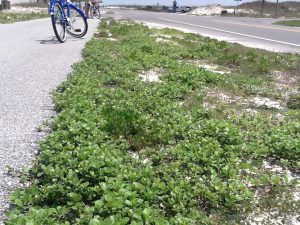
Vitex beginning to take over bike path on Pensacola Beach. Photo credit: Rick O’Connor
We tried to educate the property owners about the issue based on what we learned in South Carolina, where there is a state task force to battle the plant, and suggested methods of removal. Many property owners began the process, which can take several treatments over several years, and, with the help of University of West Florida students, removed all of the vitex from public land on Santa Rosa Island. We were feeling good that we might still be able to eradicate this plant from our county… and then I went for a hike in the Gulf Islands National Seashore… yep… found more… almost 10,000 m2 of the plant. UWF and Sea Grant have worked hard over the past year to remove these plants, and have removed all but one section. Recently I received an email letting me know that it was found in Franklin County. They have since logged this on EDDmaps and have begun the removal process. However, this begs the question… where else might this plant be in the panhandle?
Beach vitex (Vitex rotundifolia) is a salt tolerant plant that does well in dry sandy soils and full sun; it loves the beach. We have found it in dune areas above the high tide line. It was brought to the United States in the 1950’s for herbarium use. By the 1980,’s the plant was used in landscaping and sold at nurseries. It was first used in dune restoration in South Carolina after Hurricane Hugo, and that was when the trouble began.
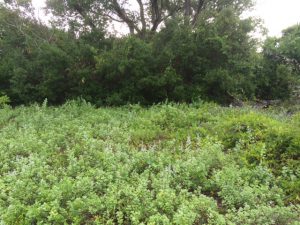
Vitex growing at Gulf Islands National Seashore that has been removed. Photo credit: Rick O’Connor
The plant grows very aggressively during the warmer months. It out competes native dune plants and quickly takes over. Growing 2-3 foot tall, this woody shrub has above ground rhizomes that can extend over 20 feet. Secondary roots begin to grow from the nodes along these rhizomes and it quickly forms an entangled mat of vines that blocks sun for some of the native plants. There has also been concern for nesting sea turtles. The rhizomes can over take a nest while incubation is occurring and entrapping the hatchlings. The plant has become such a problem in both North and South Carolina that a state task force has been developed to battle it. Vitex can spread either vegetative or by seed, both can tolerate being in salt water and can be dispersed via tides and currents. The plant has 1-2” ovate leaves and violet colored blossom, which can be seen in late spring and summer. The leaves become a rusty gray color during winter. The seeds, which are found in late summer and fall, are spherical and gray-purple in color. Vitex produces many seeds, an estimated 22,000/m2, and – in addition to being carried by the tide – can be transported by birds as well.
Again, we are hoping that the plant has been discovered early enough to control, if not eradicate, it… HOWEVER, WE NEED YOUR HELP. If you think you may have seen this plant along your coasts, please contact your county Sea Grant Extension Agent for advice on how to manage it.
















